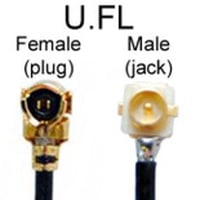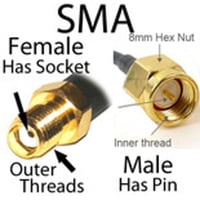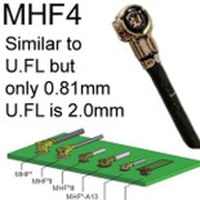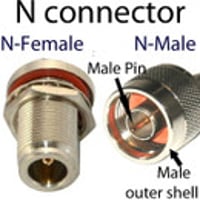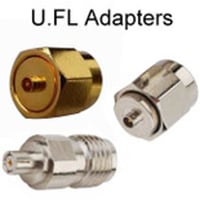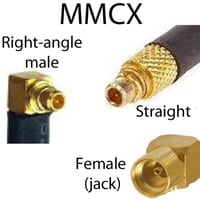U.FL Adapters
SMA to U.FL and RP-SMA to U.FL Adapters
Our U.FL adapters provide miniature interfaces that make them useful in high-density applications such as those used in WiFi, LTE, Bluetooth, BLE, LoRa, LoRaWAN, ZigBee, and GPS applications. Our SMA to U.FL adapters are made of stainless steel and brass bodies and come with a Voltage Standing Wave Ratio of between 1.3 and 6GHz.
U.FL is also known as UMCC (Ultra Miniature Coax Connectors) - U.FL Series
- U.FL connectors are tiny radio frequency connectors that operate on the 6GHZ high-frequency band. U.FL is used in a wide variety of applications mostly as antenna cable connectors. The series finds use in applications such as GPS connectors, antenna jacks MiniPCI cards, and any embedded systems on which space is critical.
- U.FL connectors are ultra-small surface mounted coaxial connectors typically with a nominal mounting area of 3.2 mm and 3.0 mm and a maximum height of 2.5 mm. Since they work with a wide range of miniature devices, you will typically get high-frequency performance from these connectors right from DC to 6GHz.
- UMCC / U.FL is an ultra low profile coaxial interconnection solution that is designed to meet the demand for miniaturization in the modern world of wireless applications. The U.FL / UMCC cable assemblies come in the form of inter-series assemblies, double ended jumpers and U.FL jack on PCB for board mount applications.
Torque Ratings
The torque rating is a fundamental specification, dictating the ideal tightness for a connection. Over-torque can damage the connector, while under-torque may not give the desired performance.
- U.FL connectors: Typically have a recommended mating torque of around 0.20 to 0.45 Nm.
- SMA connectors: Often have a recommended torque of 0.8 to 1.1 Nm for brass and 1.13 to 1.35 Nm for stainless steel.
- RP-SMA connectors: Share similar torque specifications as SMA connectors.
Compatible Wireless Technologies
U.FL, SMA, and RP-SMA connectors are synonymous with cutting-edge wireless technologies. The U.FL connectors, for instance, are frequently found in mini-PCI cards used for WiFi, while SMA and RP-SMA connectors are prevalent in RF (Radio Frequency) applications, such as antennas, routers, and wireless networking equipment.
- U.FL connectors: Generally used in internal wireless equipment due to their minute size.
- SMA connectors: Known for RF applications, they offer high performance and reliability, making them ideal for antennas in wireless communication.
- RP-SMA connectors: Reverse Polarity SMA connectors are often employed in WiFi routers and wireless devices, ensuring compliance with specific regulations.
Materials Composition
Material quality significantly impacts the durability and performance of connectors:
- U.FL connectors: These are primarily composed of gold-plated phosphor bronze or beryllium copper.
- SMA and RP-SMA connectors: They are usually made from brass or stainless steel, with gold or nickel plating for enhanced conductivity and corrosion resistance.
Types & Key Features
-
U.FL to SMA:
- Type: A coaxial cable adapter connecting a U.FL connector to an SMA.
- Key Features: Allows devices with U.FL connectors to be linked externally with antennas having SMA connectors, enhancing the range and signal strength.
-
U.FL to RP-SMA:
- Type: A coaxial cable adapter that mates U.FL connectors with RP-SMA connectors.
- Key Features: Predominantly used in WiFi equipment, it allows for easy connection to external antennas for better wireless coverage.
Applications
- Internet of Things (IoT): For small devices that need wireless connectivity, U.FL connectors provide an optimal balance of size and performance, while SMA and RP-SMA connectors link these devices to more powerful external antennas.
- Wireless Communication: Including satellite communication, ham radios, and cellular technologies.
- WiFi Routers and Access Points: Where RP-SMA connectors are standard, allowing users to replace antennas for enhanced signal reach.
- Drones and RC Devices: Leveraging the compact nature of U.FL connectors and the superior connectivity of SMA and RP-SMA.

